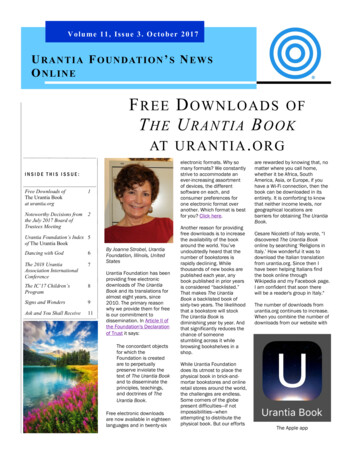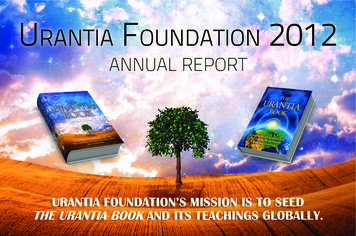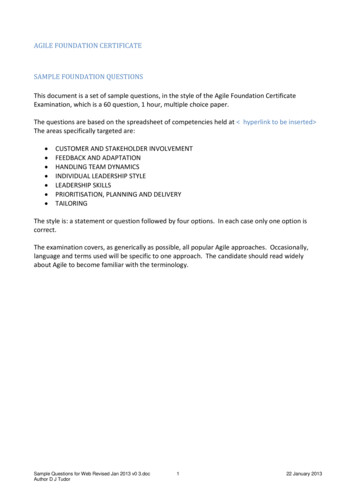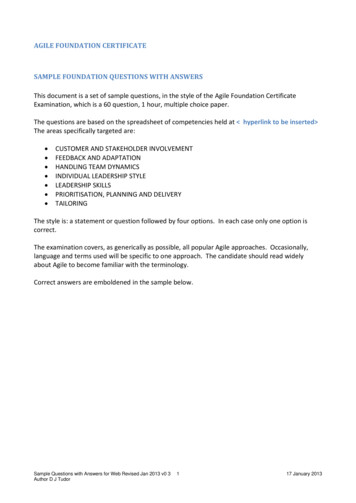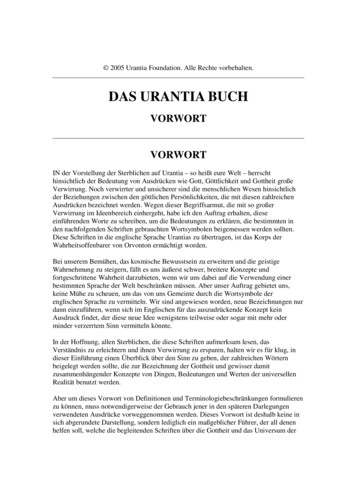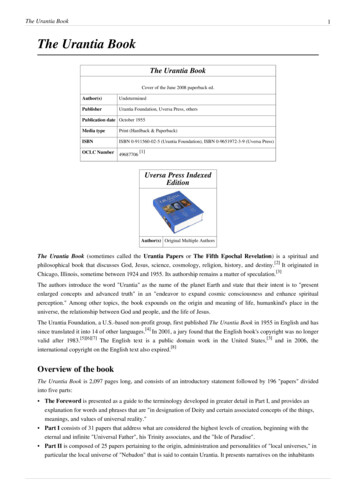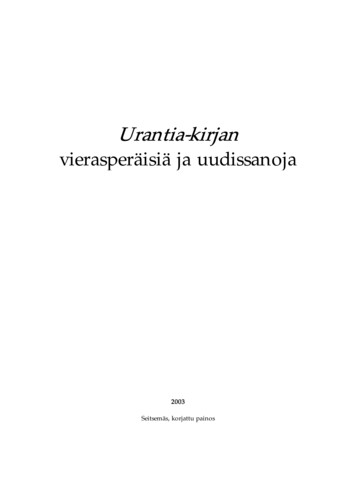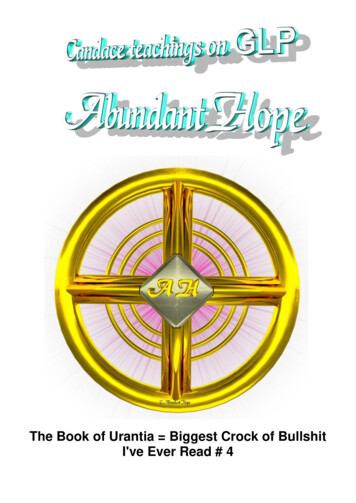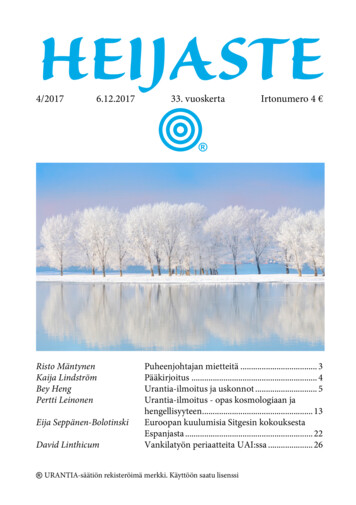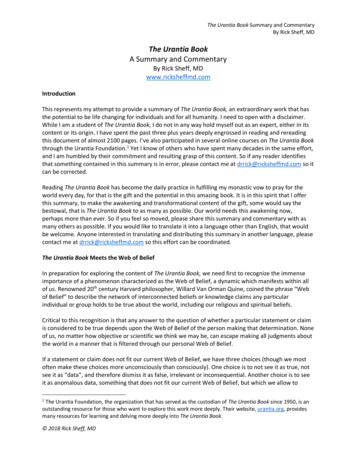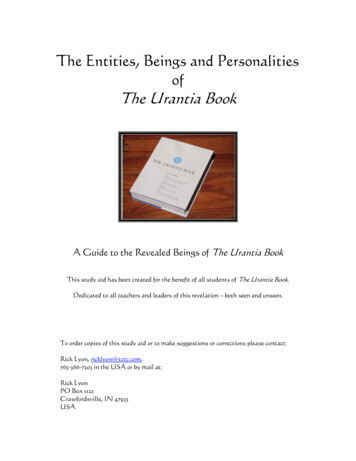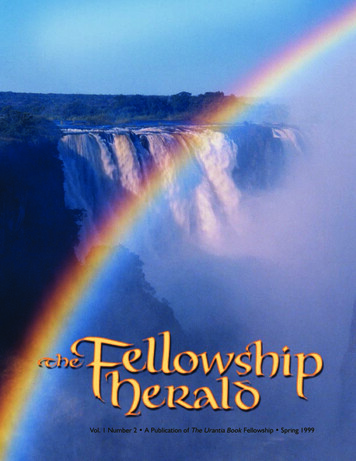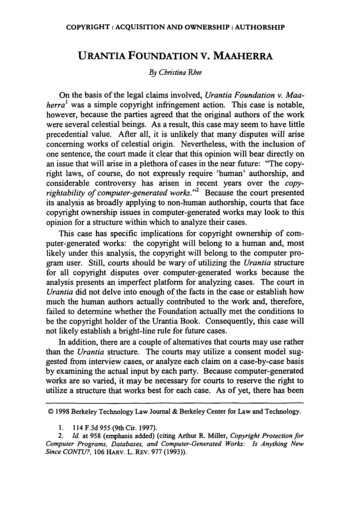
Transcription
COPYRIGHT: ACQUISITION AND OWNERSHIP: AUTHORSHIPURANTIA FOUNDATION V. MAAHERRABy ChristinaRbeeOn the basis of the legal claims involved, UrantiaFoundation v. Maaherra' was a simple copyright infringement action. This case is notable,however, because the parties agreed that the original authors of the workwere several celestial beings. As a result, this case may seem to have littleprecedential value. After all, it is unlikely that many disputes will ariseconcerning works of celestial origin. Nevertheless, with the inclusion ofone sentence, the court made it clear that this opinion will bear directly onan issue that will arise in a plethora of cases in the near future: "The copyright laws, of course, do not expressly require 'human' authorship, andconsiderable controversy has arisen in recent years over the copyrightability of computer-generatedworks.",2 Because the court presentedits analysis as broadly applying to non-human authorship, courts that facecopyright ownership issues in computer-generated works may look to thisopinion for a structure within which to analyze their cases.This case has specific implications for copyright ownership of computer-generated works: the copyright will belong to a human and, mostlikely under this analysis, the copyright will belong to the computer program user. Still, courts should be wary of utilizing the Urantia structurefor all copyright disputes over computer-generated works because theanalysis presents an imperfect platform for analyzing cases. The court inUrantiadid not delve into enough of the facts in the case or establish howmuch the human authors actually contributed to the work and, therefore,failed to determine whether the Foundation actually met the conditions tobe the copyright holder of the Urantia Book. Consequently, this case willnot likely establish a bright-line rule for future cases.In addition, there are a couple of alternatives that courts may use ratherthan the Urantia structure. The courts may utilize a consent model suggested from interview cases, or analyze each claim on a case-by-case basisby examining the actual input by each party. Because computer-generatedworks are so varied, it may be necessary for courts to reserve the right toutilize a structure that works best for each case. As of yet, there has been 1998 Berkeley Technology Law Journal & Berkeley Center for Law and Technology.1. 114 F.3d 955 (9th Cir. 1997).2. Id. at 958 (emphasis added) (citing Arthur R. Miller, Copyright ProtectionforComputer Programs, Databases, and Computer-Generated Works: Is Anything NewSince CONTU?, 106 HARv.L. REv. 977 (1993)).
BERKELEY TECHNOLOGY LAW JOURNAL[Vol. 13:69no case law on copyright ownership for computer-generated works, but itis likely that such cases will arise as computer programs become increasingly sophisticated.3I.CASE SUMMARYA. Statement of the FactsThe Urantia Foundation claimed that Maaherra infringed its copyrightby copying the Urantia Book verbatim.4 Both parties believed that theUrantia Book was authored by several celestial beings known as the Divine Counselor, the Chief of the Corps of Superuniverse Personalities, andthe Chief of the Archangels of Nebadon. 5 At the turn of the century, psychiatrist Dr. Sadler counseled a patient he believed was channeling therevelations of these celestial beings. 6 Dr. Sadler and other devotees of thecelestial beings formed a "Contact Commission" in order to study thesecommunications. 7 The followers of the celestial beings believed that thecommunications were divine teachings and wished to better understandthem in order to be able to share them with the rest of the world. 8 Themembers of the Contact Commission posed questions to the beings andrecorded their answers. The Contact Commission subsequently accumulated the questions and answers to form the Urantia Papers (Papers). 9Later, the Contact Commission members formed the Urantia Foundation (Foundation) in order "to preserve and disseminate the teachingscontained in the Papers."' 0 After it created the Foundation, the ContactCommission transferred the printing plates for the Papers to the Foundation. In 1955, the Foundation published The Urantia Book (Book) basedon the Papers, and in 1956, it received a copyright on the Book.'1 In 1983,3. Commentators state that the advent of the growing use of computers and artificial intelligence may give rise to new issues of copyrightability. See Pamela Samuelson,Allocating Ownership Rights in Computer-Generated Works, 47 U. PT. L. REv. 1185,1187 (1986); Andrew J. Wu, Dealing with Copyright Aspects of Computer-Aided Authorship: New Class of Disputes Between Programmersand Users, 13 No. 9 COMPUTER L.STRATEGIST 1, 1 (1997).4. See Urantia, 114 F.3d at 958.5. See id. at 957.6. See id.7. See id.8. See id.9. See id.10. Id.11. See id.
1998]URANTIA FOUNDATION v. MAAHERRA0applied for and received a timely renewal of the copythe Foundation12right.In 1990, Maaherra, an avid reader of the Book, created a study aid thatincluded the entire text of the Book. 13 She distributed the study aid forfree on computer disks. 14 When the Foundation discovered that she wasdistributing the disk, it filed suit alleging copyright infringement. 5 Bothparties conceded that Maaherra copied the Book in its entirety. 16 In herdefense, however, Maaherra contended that because there was no humanauthor there could be no valid copyright in the Book. 17 Additionally, sheclaimed that both the transfer and the renewal of the copyright were invalid. 8 Maaherra asserted that the Foundation could not adequately "estab'1 9lish how it had become the 'proprietor' of the copyright in the Papers"and that it inappropriately "claim[ed]renewal as the 'proprietor of copy20hire.'formadeworkainrightB. Procedural HistoryThe Foundation originally brought this case in the United States District Court for the District of Arizona. 2 1 Senior District Judge Warren K.Urbom granted Maaherra summary judgment on the renewal issue.22 Thejudge found that the renewal improperly described the Book as a work forhire and that the Foundation was not entitled to the renewal without proofthat it was the proprietor of the work. 23 The Foundation appealed this decision to the Ninth Circuit Court of Appeals.12. See id.* 13. See Urantia, 114F.3dat957.14. See id.15. See id. at 958. There were several other claims as well at the district court level.See Urantia Foundation v. Maaherra, 895 F. Supp. 1338 (D. Ariz. 1995); Urantia Foundation v. Maaherra, 895 F. Supp. 1328 (D. Ariz. 1995); Urantia Foundation v. Maaherra,895 F.Supp. 1329 (D.Ariz. 1995); Urantia Foundation v.Maaherra, 895 F. Supp. 1337(D. Ariz. 1995); Urantia Foundation v. Maaherra, 895 F. Supp. 1335 (D. Ariz. 1995).16. See Urantia, 114F.3dat956.17. See id.at 958.18. See id.at 959-60.19. See id.at 959.20. See id.at 960.21. See Urantia Foundation v.Maaherra, 895 F.Supp. 1347 (D.Ariz. 1995), rev'd144 F.3d 955 (9th Cir. 1997).22. See id.at 1354.at 1352-54.23. See id.
BERKELEY TECHNOLOGY LAW JOURNAL[Vol. 13:69II. COURT'S ANALYSISA. Ownership of the CopyrightThe court first addressed Maaherra's contention that the Foundationdid not own the copyright in the Book. Maaherra argued that because celestial beings authored the Book, "it lack[ed] the requisite ingredient ofhuman creativity, and that therefore the Book [was] not a 'work of authorship' within the meaning of the Copyright Act."2 The court found thatthe Book met the originality requirements proscribed by the Copyright26v. Rural Telephone Service Co., Inc.Act 2 5 and Feist Publications, Inc.27and therefore was copyrightable.The court began its analysis by looking to the Copyright Act. Thecourt stated that the copyright laws do not require human authorship, butrather some element of human creativity. 28 The court found that the Bookwas a compilation as defined in section 101 of the Copyright Act, becauseit had been compiled, selected, and coordinated from the original communications. 29 Section 103 provides that compilations are copyrightable, so,the court reasoned that the first humans to compile the information wouldlegitimately own the copyright.30 Because the members of the ContactCommission were, evidently, the first humans to arrange the informationgathered from the celestial beings, the court foundthat they were entitled31to the copyright in the Book as a compilation.The court next turned to the Feist originality standard for compilations.32 In that case, the Supreme Court interpreted the "originality"threshold for compilations as requiring "that the work was independentlycreated by the author (as opposed to copied from other works), and that it24. See Urantia, 114 F.3d at 958.25. 17 U.S.C.A. §§ 101, 102(a), 103 (West 1998).26. 499 U.S. 340 (1991).27. See Urantia, 114 F.3d at 958-59.28. See id. at 958.29. See id. Section 101 states that "[a] 'compilation' is a work formed by the collection and assembling of preexisting materials or of data that are selected, coordinated,or arranged in such a way that the resulting work as a whole constitutes an original workof authorship." 17 U.S.C.A. § 101 (West 1998).30. See Urantia, 114 F.3d at 958 ("Those who were responsible for the creation ofthe tangible literary form that could be read by themselves as 'authors,' because theywere responsible for the revelations appearing 'in such a way' as to render the work as awhole original.") (citing Feist, 499 U.S. at 358.)31. See id. at 958.32. See id. at 958-59.
1998)URANTIA FOUNDATION v. MAAHERRApossesses at least some minimal degree of creativity.' 3 3 According to theUrantia court, the Contact Commission's questions to the spirit and thefollowing arrangement of the Papers fulfilled the minimum requirementfor creativity. 34 Hence, the court found that the Contact Commissionowned a35common law copyright in the Urantia Papers at the time of itscreation.36B. Transfer and Renewal of the CopyrightHaving found that the Contact Commission was the copyright holderof the Papers, the court next looked at the validity of the copyright transferto the Foundation and the validity of the copyright renewal. The courtfound that the Contact Commission demonstrated its intent to transfer itscommon law copyright in the Urantia Papers to the Foundation by drawing up a trust with the Foundation as the beneficiary of the Papers.37 Thisclear intent to transfer the copyright combined with the action of actuallytransferring the printing plates for the Papers to the Foundation were sufficient to complete legal transfer of the common law copyright to the Foundation. 38 Consequently, the Foundation39 owned the copyright in the Bookat the time of the alleged infringement.The court also found that the renewal of the copyright was valid. Thecourt stated that timeliness was the most important factor in copyright renewals.The Foundation met this requirement by submitting the application for the renewal before the deadline.4 ' In addition, the court notedthat small inadvertent mistakes do not invalidate an otherwise valid renewal. 42 Accordingly, the court found that the Foundation's erroneousidentification of the Book as a work "made for hire" did not invalidate therenewal.43 Ultimately, the court ruled that the Urantia Foundation held a33. Id. at 958 (emphasis added).34. See id. at 959.35. See id. at 960.36. This comment will primarily focus on the copyrightability of the work in question. Specifically, this comment focuses on the case's effect on the copyrightability ofcomputer-generated data. Consequently, the other two issues of transfer and renewal, arenot as relevant to the discussion.37. See Urantia, 114 F.3d at 960.38. See id.39. See id.40. See id. at 961.41. See id.42. See id. at 963.43. See id. at 962-63.
BERKELEY TECHNOLOGY LAW JOURNAL[Vol. 13:69valid copyright based on all three issues of authorship, transfer, and renewal.4 4III. DISCUSSIONA. Originality StandardThe court did not address all of the facts required to satisfactorily determine whether the Book possessed the minimum level of creativity necessary for the compilation copyright. The court reached the conclusionthat the Book was copyrightable as a compilation and that the Foundationwas the appropriate owner of that copyright. However, the steps the courttook to reach that conclusion were too perfunctory. The court gave thecopyright to the Foundation simply because the court believed that themere posing of questions and the arrangement of the information fulfilledthe minimum level of creativity.45 Instead, the court should have morecritically analyzed the amount of creativity the Contact Commission actually injected into the work.As noted above, the Supreme Court recently laid out the proper test forthe copyrightability of compilations.46 The Supreme Court stated thatcompilations are copyrightable only when the author infuses some originality in the selection, coordination, or arrangement of the pre-existingmaterial.47 Since the Feist decision, the Federal Courts of Appeals haveapplied it to several cases.4 8 In general, the courts have found that themere compilation of facts is insufficient for a copyright because the requi44. See id. at 957.45. "[T]he members of the Contact Commission chose and formulated the specificquestions asked. These questions materially contributed to the structure of the Papers, tothe arrangement of the revelations in each Paper, and to the organization and order inwhich the Papers followed one another." Id. at 959.46. See Feist Publications, Inc. v. Rural Telephone Service Co., Inc., 499 U.S. 340(1991).47. See id. at 358.48. See Warren Publishing, Inc. v. Microdos Data Corp., 115 F.3d 1509 (11th Cir.1997) (finding that an efficient method for gathering information does not impart thenecessary originality for a copyright in a directory of cable television systems); CCC Information Services, Inc. v. Maclean Hunter Market Reports, Inc., 44 F.3d 61 (2nd Cir.1994) (finding that division of regions, selection of included material and valuations wasoriginal enough for a copyright on book containing used car valuations); Bellsouth Advertising & Publishing Corp. v. Donnelley Information Publishing, Inc., 999 F.2d 1436(1 th Cir. 1993) (stating that there was difference between creation and discovery for therequirement of originality); Victor Lalli Enters., Inc. v. Big Red Apple, Inc., 936 F.2d671 (2nd Cir. 1991) (finding that the charts containing the winning numbers for a racetrack were void of any creativity).
1998]URANTIA FOUNDATION v. MAAHERRAsite originality is missing. 49 On the other hand, when a compiler takes themore than disfacts and places them into a format that requires something50covery or efficiency, the compilation is copyrightable.According to the court in Urantia case, the Contact Commission'squestions to the celestial beings "materially contributed to the structure ofthe Papers, to the arrangement of the revelations in each Paper, and to the51organization and order in which the Papers followed one another."However, facts revealed at the district court level suggest that the ContactCommission may not have created the questions or arranged the Papers.District Judge Urbom. analyzed the relationship between the celestial beings and the Contact Commission. Instead of finding that the ContactCommission took the lead in any discussion or questioning, Judge Urbomfound that the Contact Commission acted in response to the directives ofthe celestial beings. The Urantia Foundation admitted that "the ContactCommission lacked any power to control the production of the 'UrantiaPapers' . ; it was the 'personalities' that determined which questionswould be considered and what would be included in the text." 52 n addition, the Judge found that the questions were actually in response to themuch of the Papers were created before the quespapers, implying that 53asked.evenweretionsThese facts suggest that the Contact Commission may not be responsible for much, if any, originality in the compilation. Rather, it seems thatthe celestial beings orchestrated the arrangement of the Papers. Instead ofconsidering these facts, the Court of Appeals glossed over them in the application of the Feist test for the copyrightability of compilations. Thecourt should have delved into how much of the work the Contact Commission actually lifted verbatim and to what extent it edited or rearranged therevelations. Also, the court should have analyzed whether the compilationwas in a predictable format which would render the work not copyrightable.In this case, the court may have been eager to give the copyright to ahuman being because "[i]ntellectual property in the United States is fun-49. See Warren Publishing,115 F.3d at 1515-16; Bellsouth Advertising, 999 F.2d at1441-44; Victor Lalli Enterprises,936 F.2d at 673.50. See Warren Publishing, 115 F.3d at 1520.51. See Urantia Foundation v. Maaherra, 114 F.3d 955, 959 (9th Cir. 1997).52. Urantia Foundation v. Maaherra, 895 F. Supp. 1347, 1353 (D. Ariz. 1995) (citation omitted).53. See id.
BERKELEY TECHNOLOGY LAW JOURNAL[Vol. 13:69damentally about incentives to invent and create." 54 Congress created theCopyright Act in order to encourage new works. 55 If an author is unableto discourage copying of his product, his incentive to create new productswill diminish. When an author is a non-human entity such as a celestialbeing or a computer, there is no one to hold or defend the copyright. Perhaps the court determined that the copyright did indeed belong to theContact Commission because that was the only pragmatic way to avoidthese issues. In cases of computer-generated works, however, the computer (non-human author) will be programmed by a human, so more oftenthan not, the issue of copyright ownership will be more complicated.B. Computer-Generated WorksIf courts strictly apply the Urantia decision to future copyright claimsover computer-generated works, they will grant the copyright to a human,most likely the computer program user. As noted above, the Urantiacourtcompared the non-human authorship of the Book to the non-humanauthorship of computer-generated data. 56 In this case, the court found thatthe Foundation was the rightful owner of the copyright in the Book because human Contact Commission members were involved in its creation."[I]t is not creations of divine beings that the copyright laws were intendedin this case some element of human creativity must haveto protect, and .occurred in order for the Book to be copyrightable. 57 By extension, thisstatement suggests that the necessary factor for computer-generated workbeing copyrightable is a minimum level of creative input by humans. Atthis stage in their development, computers do not have the capability tothink or create completely on their own, so there is always an element ofhuman input involved. Under this court's analysis, then, the Urantiaholding would probably mean58that the computer-generated works arecopyrightable by those humans.54. ROBERT P. MERGES ET AL., INTELLECTUAL PROPERTY IN THE NEW TECHNOLOGICAL AGE 12 (1997).55. See id.56. See Urantia, 114 F.3d at 958.57. See id.58. This case confirms the view of most commentators who believe that computergenerated works are copyrightable and that the copyright should belong to a human. SeeMiller, supra note 2, at 1058 ("Although commentators have differed as to who should beconsidered the author of a computer-generated work, they seem to agree that it should bea human being or legal entity, even though identifying that author may not always beeasy - especially when the human element is highly attenuated.") (citing Samuelson, supra note 3, at 1224-28).
1998]URANTIA FOUNDATION v. MAAHERRAUnder the logic of the Urantiacase, future courts would not only grantcopyrights in computer-generated works to humans, but they most likelywould grant the copyright to the computer program user with no recognition to the programmer or the owner of the program. As noted above, because this case does not delve into the rights of the other parties in thecreation of the work, the court deemed the copyright to be purely theproperty of the compiler. In the case of computer-generated works, thecounterpart to the compiler would be the user of the program. The program user inputs certain data and parameters to guide the computer's responses. The end creation would be, in part, a product of the tasks theuser instructed the program to perform. Under this court's formulation,because the user contributed to the structure and arrangement of the finalproduct, the user would be entitled to the copyright on the work as a compilation.C. Problems in the Application of This Case to Computer-GeneratedWorksBecause the analysis from this case is so perfunctory, future courtsfaced with disputes over copyrights in computer-generated works shouldbe reluctant to utilize such a bright-line rule. In computer-generatedworks, there are many different types of programs that require differinglevels of input. These works vary widely: from an essay that an authorcreates on her own using a word processor to musical compositions thatare created almost completely by a computer with minimal input by a user.Because the amount of originality involved in creation of the work variesevery case the copyrightso widely, it may be inappropriate to state that in59program.theofuserthetosolelybelongshouldIn addition, a compilation structure does not seem to be the best paradigm for analyzing computer-generated works. In many compilationssuch as telephone books or automobile price quotation books, the factsthemselves are not copyrightable and are in the public domain. In such acase, the compiler does not vie for the copyright in the compilation againstsomeone else. In a computer program, on the other hand, many of theelements are copyrightable by the6Programmer including the literal andnonliteral elements of the program.59. Even Professor Samuelson, who generally proposes giving the user the copyright in the computer-generated work, recognizes that in some cases where the work "incorporates a substantial block of recognizable expression from the copyrighted program"there should be an exception to this rule. Samuelson, supra note 3, at 1192.60. See, e.g., Apple Computer v. Franklin Computer, 714 F.2d 1240, 1246-49 (3dCir. 1983) (stating that computer programs in object code, source code, and embedded in
BERKELEY TECHNOLOGY LAW JOURNAL[VoL 13:69Because the compilation or the computer-generated work will mostlikely be a product of copyrighted elements, clip art, music, etc., the usermay have to vie for the copyright against the owner of the copyrightedworks incorporated into the program. For example, in a recent article, TalVidgerson explored the rights of authors versus the rights of programmersof computer-generated "read-alike" works. 61 Vidgerson based his articleon a programmer who programmed his computer to write a book in thestyle of a famous deceased author, Jacqueline Susann. He copied her styleof writing and reduced it to "6000 computer-programmed rules equallinghundreds of thousands of lines of computer code." 6 2 In a program like thisone, the programmer has imparted most of the creativity in the creation ofthe work. The program user would only need to press "enter" or type"compose" and the computer would create a novel in the style of Jacqueline Susann. Even though the novel is a new creation by the computeruser, the programmer enabled the computer to create the work with littleadditional input. The original author, the programmer, and the programuser could all have competing claims to the copyright of the computergenerated end-product. In this case, it would be inequitable to grant thecopyright to the user when he contributed the least work and little, if any,creativity.D. Alternatives To A Strict Compilation Structure With Which ToAnalyze These Cases: Case-by-Case Analysis and Interview/Consent ModelCourts that face the issue of copyright ownership of computergenerated works may choose to follow the Urantia structure or use a different analysis altogether. One option the courts could use would be toanalyze each claim on a case-by-case basis to determine how much of theend product is due to the creative input of each party involved.63 In thisway, a court can fairly evaluate who should own the copyright or whetherthe parties should share the copyright. Unfortunately, however, this mayROM are copyrightable); Stern Electronics, Inc. v. Kaufman, 669 F.2d 852, 856-58 (2dCir. 1982) (protecting computer program audio/visual elements under copyright).61. Tal Vidgerson, Hamlet 11: The Sequel? The Rights of Authors vs. ComputerGenerated "Read-Alike" Works, 28 LOY. L. REv. 401 (November 1994).62. See id. at 405-06.63. See LEGAL RESEARCH NETWORK, INC. ET AL, RULES OF THE ROAD FOR THEINFORMATION SUPERHIGHWAY: ELECTRONIC COMMUNICATIONS AND THE LAW § 32.2(1996) ("The particular solution to the conflicting claims of the author of the program,the user, and the owner of the computer is likely to depend on the facts of the particularcase, rather than on a generalized rule of attribution of ownership."); see also Miller, supra note 2, at 1059.
19981URANTIA FOUNDATION v. MAAHERRAprove to be a drain on the courts' time and resources if the courts wereobligated to analyze the facts of each copyright dispute.Another alternative to the strict compilation structure would be the interview/consent model. Though the Urantia court viewed the Book as astrict compilation, that is not the only, or even, the most logical paradigm.Another more logical approach that the court could have taken would havebeen to view the interactions between the Contact Commission and thecelestial beings as an interview because the posing of questions and recording of the answers falls into the basic structure of an interview.In cases where the published work in question is an interview, thecopyright has generally fallen to the interviewer as the author of the interview. "Regardless of who owns the copyright in each of the quoted passages in the article, there can be no doubt that [the interviewer] owns thecopyright in his compilation of the quotations." 64 Because the work is aninterview, the courts reason that the structure fulfills the necessary creativity for an interviewer copyright in a compilation. 65 This type of analysis may be more appropriate for the Urantia case because the facts, as theas interview structure bettercourt viewed them, seem to fit a compilation66structure.compilationstrictathanMore importantly, courts pay special attention to the fact that interviewees typically6 rant permission to the interviewer to use the quotationsin the final work. In Estate of Hemingway v. Random House, Inc.,68 thecourt stated that Hemingway's willingness to let Hotchner take notes oftheir conversations and write articles based on the articles preempted anycommon law copyright Hemingway's estate could have claimed on Hemingway's quotations. 69 Similarly, in Urantia, the celestial beings were64. See Quinto v. Legal Times of Washington, Inc., 506 F. Supp. 554, 559 (1981).65. See Vicki L. Ruhga, Ownership of Interviews: A Theory for Protection ofQuotations, 67 NEB. L. REv. 675, 684 (1988) ("Several courts maintain that the interviewer is the sole owner of a work consisting of quotations. The courts reason that theinterviewer recreates the conversation, organizes the article and forms the literary expres-sion.") (citation omitted).66. Of course, because interviews are viewed as compilations, the interviewer stillneeds to impart the necessary amount of originality required by the Court in Feist in order to hold a copyright on the interview. See Feist Publications, Inc. v. Rural TelephoneService Co., Inc., 499 U.S. 340, 358 (1991).67. See Quinto, 506 F. Supp. at 559 ("Even if [the plaintiff] did not own the copyright to the quotations in his article, he had permission to use the quotations and his copyright in the compilation protects his selection, arrangement, and ordering of them.")68. 296 N.Y.2d 341 (1968).69. "For the present purposes, it is enough to observe that Hemingway's words andconduct, far from making any such reservation, left no doubt of his willingness to permitHotchner to draw freely on their conversation in writing about him and to publish such
BERKELEY TECHNOLOGY LAW JOURNAL[Vol. 13:69willing to let the Contact Commission take the revelations and, at the veryleast, transcribe them. There is no indication that the celestial beingswould have disapproved of the Contact Commission publishing the work.On the contrary, the facts revealed in the district court state that the celestial beings directed which questions would be in the text.70 If the Foundation could show that the celestial beings expected that the works would bepublished and did not disapprove, then under the interview as compilationstructure, the Foundation may be a valid copyright holder as an interviewer.While the interview paradigm laid out above may not seem to fit thecomputer situation any better than the basic compilation analysis, thosecases provide an important insight courts should utilize going forward:the relevance of consent. In the interview cases, courts viewed the interviewee's consent to the interview as permission to the interviewer to utilize the information gained in the interview. In comparison, programmerconsent in the forms of contract, licensing, or payment could enable theuser of a program to copyright the end product. Professor Samuelson argues that in those cases where the programmers get something in returnfor sale or license of their program, the programmers should yield some oftheir rights. 7 1 Also, if the programmers choose not to give up their rights,they always have the option not to distribute the program.When courts are faced with the issue of copyright in computergenerated data, they will have alternatives to the Urantia structure: caseby-case analysis and a consent model may
URANTIA FOUNDATION V. MAAHERRA By Christina Rbee On the basis of the legal claims involved, Urantia Foundation v. Maa-herra' was a simple copyright infringement action. This case is notable, however, because the parties agreed that the origin
